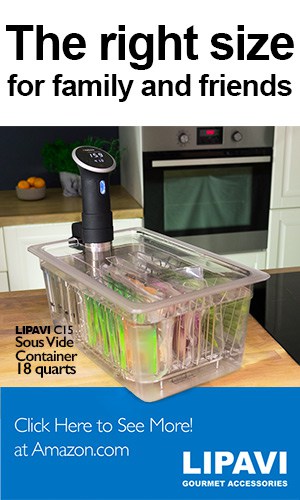-
Sous Vide Time and Temperatures
Sous Vide Time and Temps
Sous Vide Time and Temps
Sous Vide Temps
- All Sous Vide Temperatures
- Sous Vide Beef Temperatures
- Sous Vide Chicken Temperatures
- Sous Vide Duck Temperatures
- Sous Vide Fish Temperatures
- Sous Vide Vegetables Temperatures
- Sous Vide Infusions Temperatures
- Sous Vide Lamb Temperatures
- Sous Vide Pork Temperatures
- Sous Vide Shellfish Temperatures
- Sous Vide Turkey Temperatures
- Recipes Recipes Recipes Recipes
- Getting Started Guides Getting Started Guides Getting Started
- Equipment and Tools Equipment and Tools Equipment Equipment and Tools
- More Resources More Resources Resources More Resources

This article is a part of my free Exploring Sous Vide email course. If you want to discover how to consistently create amazing food using sous vide then my course is exactly what you're looking for. For a printed version of this course, you can purchase my Exploring Sous Vide cookbook.
How to Sear Sous Vided Foods
Click here to get great sous vide content via email
This post may contain affiliate links. Read more.
Written by Jason Logsdon
One of the areas sous vide falls short is creating that nice flavorful, brown crust on foods. Luckily there are several ways to finish of foods after they have been sous vided to create the crust without further cooking the food.
The whole goal of post-sous vide browning is to create the crust while heating the interior of the food as little as possible. The main keys to accomplishing this goal are dry foods, high temperatures, and short times.


Prepping Sous Vide Food For Searing
The most important thing to do before searing is to thoroughly dry it off. Moisture that is on the surface of the food will prevent it from browning, increasing the cooking time needed, and potentially heating the food further. Properly drying the food after sous viding is critical but easy.
After you take the food out of the pouches pat it food dry, either with paper towels or clean kitchen towels. I have a certain set of smaller towels that I only use to dry off food after sous vide, but paper towels will work well. I tend to dry it off at least 15 minutes before I will sear it, allowing the remaining moisture to evaporate and the meat to cool slightly.
For some preparations you can add a coating to the meat before searing it as well. A light dusting of flour or corn meal will help create a crust faster and add some flavors. Heavier coatings are also good for specific foods like breaded or fried chicken, beef Wellington, or herb crusted steaks.
If you want to ensure you get a deep crust without overcooking the inside of the food you can also cool the food down more before searing it. This gives you more of a leeway in your browning time before the temperature of the inside of the food is raised too much.
My best-selling Modernist Cooking Made Easy: Sous Vide also explores these items in much more detail.
Ways of Searing Your Food After Sous Vide
Maintaining high temperatures and short times for your searing is critical and it all comes down to what method you are using to sear it.
Pan Sear or Cast Iron
Pan searing your sous vide food is the easiest method for most people. It's also especially effective if you have a heavy pan or a good cast iron pan.

The process of searing it in a pan is simple. First make sure your sous vide food is completely dry. Heat a thin film of oil in the pan over medium-high to high heat until right before it starts to smoke. Add the meat to the pan, being careful of splattering, and cook for 45 to 90 seconds per side, just until the food browns.
Oven
The oven is pretty effective for certain types of browning. The broiler can be used for steaks or thinner cuts and the oven itself can be turned up high to brown roasts.
One of my favorite meals is sous vided prime rib roasts. After the sous vide process I'll coat them with a garlic-herb mixture and put it in the oven set to 500°F (260°C) and let the crust brown before serving it.
Grilling
If you have a high-quality grill it can be used effectively for sous vide browning.
For gas grills, make sure it is turned all the way up, close the lid and let the bars fully heat. Brush some oil on the meat and place on the grill, leaving the lid open. Cook for 45 to 90 seconds per side, just until it browns and grill marks form.

For charcoal grills you want the coals as hot as possible. Some people even cook directly on top of their chimney-style starter to maximize the heat. Just brush the meat with some oil and place on the grill, leaving the lid open. Cook each side for 45 to 90 seconds until grill marks form.
Sous Vide Torch
A favorite method of finishing sous vide is using a torch. The torch quickly browns the outside of the foods and gives you better control than searing in a pan. It is especially good for uneven foods. A down side of using the torch is that the food can sometimes develop a discernible "torch taste", though it is not something I have personally experienced.

There are many different torches but the most recommended are typically the Bernzomatic TS8000 and the Iwatani Torch. The smaller pastry-style torches usually aren't powerful enough for proper browning. For a more detailed look at the torches available you can check out our detailed guide to sous vide torches and a comparison between the Bernzomatic TS4000 and TS8000 torches.
Searzall

The Searzall is a fun addition to torches. Made by Dave Arnold from the French Culinary Institute it's an add-on for the Bernzo TS8000 torch that helps to diffuse the flame, making it better for cooking with.
As the Searzall site says it works by "forcing the torch's flame through two layers of fine, heatproof alloy mesh converting the majority of the flame to infra-red, radiant heat - a cook's best friend".
Deep Frying
One method of browning that people don't think of is deep frying the food. The whole concept behind deep frying is to quickly brown the outside of foods while keeping the inside tender...and that's exactly what we're looking for in a sous vide finishing technique.
To deep fry your food, heat a pot of oil to around 375°F to 400°F (190°C to 204°C), making sure the pot is less than half way full or it can bubble out. Make sure your food is completely dried off then place into the oil. It should take 30 to 90 seconds to fully brown the food. Remove it from the oil and you're all set.
How do you do finish your food after sous viding it?
Have questions or comments about finishing your food?
Let Me Know on Facebook or in the comments below!
Have questions or comments about finishing your food?
Let Me Know on Facebook or in the comments below!
Do you know anyone that is struggling with sous vide and would find this information helpful? Why not do them a favor and send them a link to this Exploring Sous Vide email course or get them a printed version of this course!
Course Link:
 Thanks again and happy cooking!
Thanks again and happy cooking!
Jason Logsdon, Amazing Food Made Easy
This article is a part of my free Exploring Sous Vide email course. If you want to discover how to consistently create amazing food using sous vide then my course is exactly what you're looking for. For a printed version of this course, you can purchase my Exploring Sous Vide cookbook.
 This article is by me, Jason Logsdon. I'm an adventurous home cook and professional blogger who loves to try new things, especially when it comes to cooking. I've explored everything from sous vide and whipping siphons to pressure cookers and blow torches; created foams, gels and spheres; made barrel aged cocktails and brewed beer. I have also written 10 cookbooks on modernist cooking and sous vide and I run the AmazingFoodMadeEasy.com website.
This article is by me, Jason Logsdon. I'm an adventurous home cook and professional blogger who loves to try new things, especially when it comes to cooking. I've explored everything from sous vide and whipping siphons to pressure cookers and blow torches; created foams, gels and spheres; made barrel aged cocktails and brewed beer. I have also written 10 cookbooks on modernist cooking and sous vide and I run the AmazingFoodMadeEasy.com website.
Affiliate Disclaimer: Some links on this site might be affiliate links that if used to purchased products I might receive money. I like money but I will not endorse something I don't believe in. Please feel free to directly go to any products I link to and bypass the referral link if you feel uncomfortable with me receiving funds.













